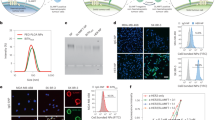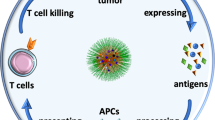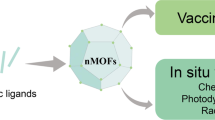Abstract
Tumour-targeted immunotherapy offers the unique advantage of specific tumouricidal effects with reduced immune-associated toxicity1,2. However, existing platforms suffer from low potency, inability to generate long-term immune memory and decreased activities against tumour-cell subpopulations with low targeting receptor levels3,4,5. Here we adopted a modular design approach that uses colloidal nanoparticles as substrates to create a multivalent bi-specific nanobioconjugate engager (mBiNE) to promote selective, immune-mediated eradication of cancer cells. By simultaneously targeting the human epidermal growth factor receptor 2 (HER2) expressed by cancer cells6 and pro-phagocytosis signalling mediated by calreticulin7, the mBiNE stimulated HER2-targeted phagocytosis and produced durable antitumour immune responses against HER2-expressing tumours. Interestingly, although the initial immune activation mediated by the mBiNE was receptor dependent, the subsequent antitumour immunity also generated protective effects against tumour-cell populations that lacked the HER2 receptor. Thus, the mBiNE represents a new targeted, nanomaterial-immunotherapy platform to stimulate innate and adaptive immunity and promote a universal antitumour response.
This is a preview of subscription content, access via your institution
Access options
Access Nature and 54 other Nature Portfolio journals
Get Nature+, our best-value online-access subscription
$29.99 / 30 days
cancel any time
Subscribe to this journal
Receive 12 print issues and online access
$259.00 per year
only $21.58 per issue
Buy this article
- Purchase on Springer Link
- Instant access to full article PDF
Prices may be subject to local taxes which are calculated during checkout




Similar content being viewed by others
References
Restifo, N. P., Dudley, M. E. & Rosenberg, S. A. Adoptive immunotherapy for cancer: harnessing the T cell response. Nat. Rev. Immunol. 12, 269–281 (2012).
Bargou, R. et al. Tumor regression in cancer patients by very low doses of a T cell-engaging antibody. Science 321, 974–977 (2008).
Baeuerle, P. A. & Reinhardt, C. Bispecific T-cell engaging antibodies for cancer therapy. Cancer Res. 69, 4941–4944 (2009).
Kalos, M. & June, C. H. Adoptive T cell transfer for cancer immunotherapy in the era of synthetic biology. Immunity 39, 49–60 (2013).
Kershaw, M. H., Westwood, J. A. & Darcy, P. K. Gene-engineered T cells for cancer therapy. Nat. Rev. Cancer 13, 525–541 (2013).
Slamon, D. J. et al. Human breast cancer: correlation of relapse and survival with amplification of the HER-2/neu oncogene. Science 235, 177–182 (1987).
Chao, M. P. et al. Calreticulin is the dominant pro-phagocytic signal on multiple human cancers and is counterbalanced by CD47. Sci. Transl. Med. 2, 63ra94 (2010).
Blattman, J. D. & Greenberg, P. D. Cancer immunotherapy: a treatment for the masses. Science 305, 200–205 (2004).
Pardoll, D. The blockade of immune checkpoints in cancer immunotherapy. Nat. Rev. Cancer 12, 252–264 (2012).
Garon, E. B. et al. Pembrolizumab for the treatment of non-small-cell lung cancer. N. Engl. J. Med. 372, 2018–2028 (2015).
Motzer, R. J. et al. Nivolumab versus everolimus in advanced renal-cell carcinoma. N. Engl. J. Med. 373, 1803–1813 (2015).
Larkin, J. et al. Combined nivolumab and ipilimumab or monotherapy in untreated melanoma. N. Engl. J. Med. 373, 23–34 (2015).
Nghiem, P. T. et al. PD-1 blockade with pembrolizumab in advanced Merkel cell carcinoma. N. Engl. J. Med. 374, 2542–2552 (2016).
Topalian, S. L. et al. Safety, activity, and immune correlates of anti–PD-1 antibody in cancer. N. Engl. J. Med. 366, 2443–2454 (2012).
Li, A. V. et al. Generation of effector memory T cell–based mucosal and systemic immunity with pulmonary nanoparticle vaccination. Sci. Transl. Med. 5, 204ra130 (2013).
Cho, N. H. et al. A multifunctional core–shell nanoparticle for dendritic cell-based cancer immunotherapy. Nat. Nanotech. 6, 675–682 (2011).
Lizotte, P. H. et al. In situ vaccination with cowpea mosaic virus nanoparticles suppresses metastatic cancer. Nat. Nanotech. 11, 295–303 (2016).
Li, H., Li, Y., Jiao, J. & Hu, H. M. Alpha-alumina nanoparticles induce efficient autophagy-dependent cross-presentation and potent antitumour response. Nat. Nanotech. 6, 645–650 (2011).
Kalinski, P. et al. Dendritic cell-based therapeutic cancer vaccines: what we have and what we need. Future Oncol. 5, 379–390 (2009).
Obeid, M. et al. Calreticulin exposure dictates the immunogenicity of cancer cell death. Nat. Med. 13, 54–61 (2006).
Jiang, W., Kim, B. Y. S., Rutka, J. T. & Chan, W. C. W. Nanoparticle-mediated cellular response is size-dependent. Nat. Nanotech. 3, 145–150 (2008).
Park, S. G. et al. The therapeutic effect of anti-HER2/neu antibody depends on both innate and adaptive immunity. Cancer Cell 18, 160–170 (2010).
Ma, Y. et al. Targeting of antigens to B lymphocytes via CD19 as a means for tumor vaccine development. J. Immunol. 90, 5588–5599 (2013).
Feng, M. et al. Macrophages eat cancer cells using their own calreticulin as a guide: roles of TLR and Btk. Proc. Natl Acad. Sci. USA 112, 2145–2150 (2014).
Liu, X. et al. CD47 blockade triggers T cell-mediated destruction of immunogenic tumors. Nat. Med. 21, 1209–1215 (2015).
Klebanoff, C. A. et al. Central memory self/tumor-reactive CD8+ T cells confer superior antitumor immunity compared with effector memory T cells. Proc. Natl Acad. Sci. USA 102, 9571–9576 (2005).
Gardai, S. J. et al. Cell-surface calreticulin initiates clearance of viable or apoptotic cells through trans-activation of LRP on the phagocyte. Cell 123, 321–324 (2005).
Green, D. R., Ferguson, T., Zitvogel, L. & Kroemer, G. Immunogenic and tolerogenic cell death. Nat. Rev. Immunol. 9, 353–363 (2009).
Mellman, I., Coukos, G. & Dranoff, G. Cancer immunotherapy comes of age. Nature 480, 480–489 (2011).
Sharma, P. & Allison, J. P. The future of immune checkpoint therapy Science 348, 56–61 (2015).
Qie, Y. et al. Surface modification of nanoparticles enables selective evasion of phagocytic clearance by distinct macrophage phenotypes. Sci. Rep. 6, 26269 (2016).
Jiang, W., Mardyani, S., Fischer, H. & Chan, W. C. W. Design and characterization of lysine cross-linked mercapto-acid biocompatible quantum dots. Chem. Mater. 18, 872–878 (2006).
Mosser, D. M. & Zhang, X. Activation of murine macrophages. Curr. Protocol. Immunol. 83, 14.2.1–14.2.8 (2008).
Weiskopf, K. et al. Engineered SIRPα variants as immunotherapeutic adjuvants to anticancer antibodies. Science 341, 88–91 (2013).
Acknowledgements
The authors thank P. Anastasiadis, L. Petrucelli, H. Crawford, J. Copland, D. Radisky, T. Gonwa and D. Page and his veterinary team for reagents and helpful discussions. We also thank L. Lewis-Tuffin for her help with flow cytometer and confocal experiments, J. A. Knight, R. Feathers, H.-J. Wen and E. E. Miller for their helpful discussions, and B. Edenfield for her assistance with immunohistological experiments. Finally, we thank C. Wogan from MD Anderson's Division of Radiation Oncology for editorial contributions and AXS Studio for preparing Fig. 4d. Research reported here was supported by the James C. and Sara K. Kennedy Award from Mayo Clinic (B.Y.S.K), Jorge and Leslie Bacardi Fund for the study of Regenerative Medicine, Mayo Clinic Center for Regenerative Medicine (B.Y.S.K.), Mayo Clinic Center for Individualized Medicine Gerstner Family Award (B.Y.S.K.), Helene Houle Mayo Clinic Career Development Award in Neurologic Surgery (B.Y.S.K.), Mayo Clinic Neuroregenerative Medicine Initiative for Neuro-Oncology Research (B.Y.S.K.), China Scholarships Council (No. 201406100114, H.Y.), DeMars Family Mayo Clinic Development Fund (B.Y.S.K.) and Strawn Family Mayo Clinic Development Fund (B.Y.S.K.).
Author information
Authors and Affiliations
Contributions
H.Y., W.J. and B.Y.S.K. conceived the study and designed the experiments. H.Y., C.A.V.R., Y.Q., X.L. and Y.C. performed the experiments and generated the data. H.Y., C.A.V. R., W.J., Y.W., R.E.W., K.Y., G.B., K.L.K. and B.Y.S.K. analysed the data and interpreted the results. All authors helped to write the paper.
Corresponding authors
Ethics declarations
Competing interests
The Mayo Clinic has filed a patent application on the technology and intellectual property reported here.
Supplementary information
Supplementary information
Supplementary information (PDF 4363 kb)
Rights and permissions
About this article
Cite this article
Yuan, H., Jiang, W., von Roemeling, C. et al. Multivalent bi-specific nanobioconjugate engager for targeted cancer immunotherapy. Nature Nanotech 12, 763–769 (2017). https://doi.org/10.1038/nnano.2017.69
Received:
Accepted:
Published:
Issue Date:
DOI: https://doi.org/10.1038/nnano.2017.69
This article is cited by
-
Genetically engineered membrane-based nanoengagers for immunotherapy of pancreatic cancer
Journal of Nanobiotechnology (2024)
-
Small-molecule-mediated control of the anti-tumour activity and off-tumour toxicity of a supramolecular bispecific T cell engager
Nature Biomedical Engineering (2024)
-
Engineering nanomaterial physical characteristics for cancer immunotherapy
Nature Reviews Bioengineering (2023)
-
Immunological conversion of solid tumours using a bispecific nanobioconjugate for cancer immunotherapy
Nature Nanotechnology (2022)
-
Pancreatic tumor eradication via selective Pin1 inhibition in cancer-associated fibroblasts and T lymphocytes engagement
Nature Communications (2022)



